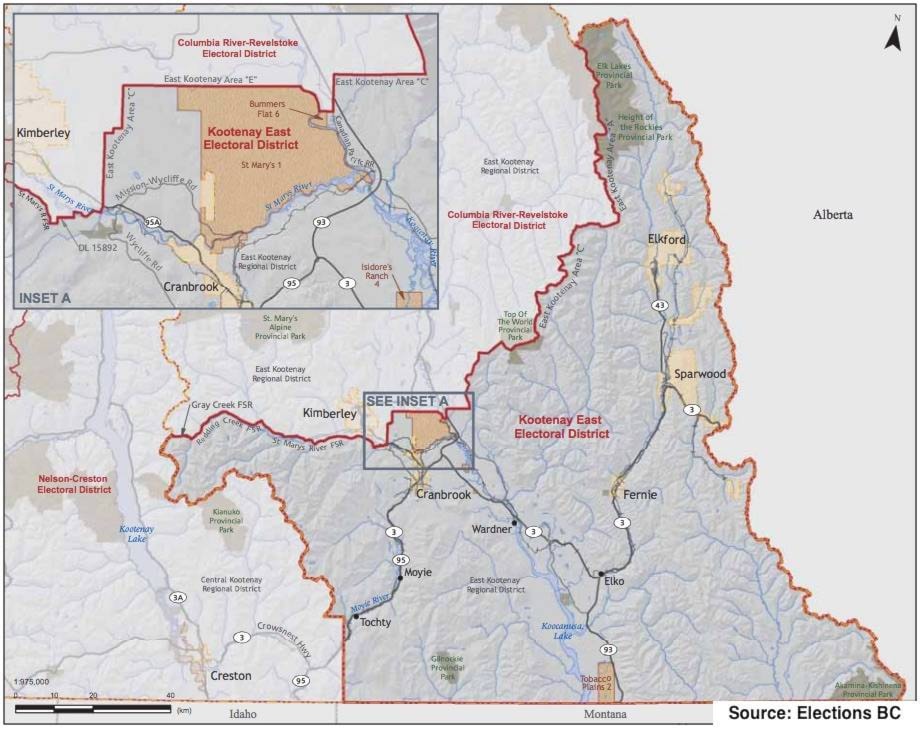The Kootenays are at risk of losing seats depending on the outcome of a review of provincial riding boundaries recently announced by the provincial government, according to Kootenay East MLA Tom Shypitka.
Under proposed changes put forward by the BC NDP government, protections for rural ridings in B.C. would be removed, while at the same time up to six new ridings could be added to the existing 87.
Shypitka said that while he has no issue with electoral boundary reviews, the proposal to remove protections was troubling for rural communities where small populations are spread over large areas.
“Clearly there’s a desire to reduce the rural seats in B.C. and increase the urban ones,” he said.
The Kootenays are mandated to retain four ridings under the current rules for electoral boundaries. Together with northern B.C. (eight ridings) and Thompson-Cariboo (five ridings), 17 ridings in B.C. are shielded from being stretched to include a similar number of voters to the rest of the provinces ridings. When the protections were introduced in 2014, MLAs across the party divide agreed that the larger more regional ridings could not be allowed to get any bigger while having only one elected MLA.
Shypitka said that this protection was vital to rural communities by ensuring ridings in areas with smaller, spread-out populations were small enough for representatives to be able to properly cover them.
Shypitka said that the move by the government is political, given the spread of party control across the rural ridings in the province.
“To repeal the protection for certain rural ridings is obviously a play on reducing the number of rural seats which are predominantly held by the B.C. Liberal Party.”
Of the 17 ridings protected, 14 are held by the B.C. Liberal Party, including two in the Kootenays.
The number of registered voters in the protected ridings can vary hugely from the numbers in more urban ridings.
The riding of Stikine in Northern B.C. had only 13,240 registered voters in the last provincial election, but covers the entire north west corner of the province, while closer to home in the Kootenays, both Kootenay East and West had about 30,000 voters each, while Nelson-Creston had 27,000 and Columbia River-Revelstoke had 23,000.
In contrast, urban ridings such as Vancouver-Mount Pleasant had over 41,000 voters, while Surrey-Cloverdale had 39,000 and Kelowna-Mission had 45,000.
According to the B.C. NDP, an increase in the number of ridings would allow greater representation for areas with growing populations.
Shypitka said that the impact of boundary reviews for urban ridings were minor compared to the damage done to rural ridings, given that including only a few extra thousand voters could mean hundreds of miles of extra territory, which would reduce a representatives ability to cover their entire riding and awareness of all the different issues in each community.
“Those are big changes when you’re talking rural ridings. In the urban ridings its a couple of city blocks - maybe a kilometre. The issues across communities in (urban) ridings are quite similar. When you get 400-500 mile ridings … those issues are much more diverse.”
Under the proposed changes, no riding in B.C. would vary from the average number of registered voters by more than 25 percent.
In the 2020 election, there were 3.15 million registered voters in B.C. Divided between the existing 87 ridings, each riding would need over 36,000 registered voters to be evenly spread across the province.
READ MORE: B.C. election law could add 6 seats, remove rural protection
scott.tibballs@thefreepress.ca
Like us on Facebook and follow us on Twitter
